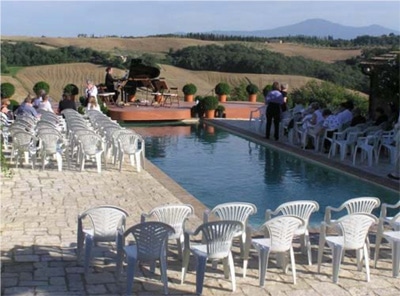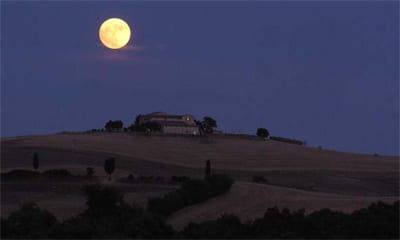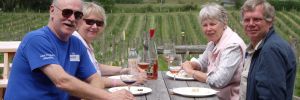Updated 5/16/11
A Dream Vacation
by Ben Manny
My wife and I spent 5 weeks last June and July visiting small cites in Italy and Germany. While this was a dream vacation for us, vacation preferences vary widely and our trip might be considered a nightmare by someone else. Most Intel retirees are already experienced business or sabbatical travelers, so I will start by listing some of our personal travel preferences.
My wife & I prefer to travel with close friends or family. This adds interesting social dynamics to any trip and can help in lowering the costs. We subscribe to the Rick Steve’s travel philosophy instead of Club Med ). We like to arrange lodging and transportation before the trip, but usually decide on the daily activities while traveling. We generally avoid large cities and prefer to experience a place instead of seeing one more sight. We prefer public transportation or a rental car over a tour bus. While shopping is not a high priority, consuming local food and wine is. We both like to hike. For our dream vacation, we shared a rental car with another retired couple, spent 10 days in Tuscany, and another 22 days in southern and eastern Germany. We flew directly from Portland to Frankfurt then onto Florence, arriving June 20th. We returned to Portland on July 24th flying from Hannover to Frankfurt then non-stop to Portland. For those interested in reading further, the rest of this article covers our accommodation itinerary, our experiences with GPS navigation, and describes what we all considered the trip highlight.
 For accommodations, we tried to rent two bedroom apartments with separate baths. In most cases we ended up sharing a bath with the other couple, which worked out fine for us. We used the kitchen for breakfast and some simple evening meals. Costs ranged from 50 to 75 US dollars per night per couple. In Italy, we stayed all ten days at Guiliana’s La Logetta in the village of Montefioralle. Montifioralle is a small hilltop
For accommodations, we tried to rent two bedroom apartments with separate baths. In most cases we ended up sharing a bath with the other couple, which worked out fine for us. We used the kitchen for breakfast and some simple evening meals. Costs ranged from 50 to 75 US dollars per night per couple. In Italy, we stayed all ten days at Guiliana’s La Logetta in the village of Montefioralle. Montifioralle is a small hilltop
village located about 30 miles south of Florence. We spent one night in Gries am Brenner, Austria, on our way to Iphofen Germany. Iphofen is a small medieval village located about 75 miles northwest of Munich, about 30 miles east of Wurzberg. We stayed at the Johann Arnold B&B located in one of the 26 small wineries in the town. An apartment was not available due to the annual 4-day Wine Festival, which is why we were there for a total of 10 days. We then traveled to East Germany and stayed in Bad Schandau for 5 days, which is along the Elbe River, just north of the Czech Republic boarder. The city adjourns a National Park, known as Saxon Switzerland, where we did some hiking. Our next visit was a 3 day stay at Felsenthal’s apartment in Tabarz, a small East German town in the Thuringer forest. As with our other stays, we took day
trips to local sites. In this case we visited a toy factory in Rudolstadt and the Wartburg castle in Eisenach. Our final 4 day stay was at Petra Hubert’s apartment in Clausthal-Zellerfeld. This is a university town close to an East German border crossing museum and the Harz Mountains.
We were pleasantly surprised by the affordable meals in the smaller cities. Most dinners averaged less than 20 dollars a person, which included a nice bottle or two of wine. Another surprise was most of the places we dined and stayed would not accept credit cards. While we had no trouble finding and using ATM’s, we had to make frequent withdrawals to pay for our rooms.
On most days we took 1 to 2 hour car trips to nearby cities and other places of interest. We would decide the night before where we wanted the next day. In Italy we visited, Greve, Badi a Passignano, Siene, Radda, Mount Oliveto’s Abby, Lucignano D’Asso, Castle di Brolio, Pisa, Luca, Volterra, San Gimignano, and Florence. Navigation was done using a GPS, which was only the size of a deck of cards but came preloaded with maps for all of Europe and useful points of interests, such as gas stations, castles, and parking lots. Intersections were detailed enough to know in advance which exit to take off a round-about. We also used the unit to locate the car after long day of sightseeing, as it also had a pedestrian mode. The unit was accurate enough to use to anticipate curves in the road, which came in handy in Italy, especially at night. The GPS really took the anxiety out of getting somewhere, including driving to a villa off a dirt road where we experienced the highlight of our trip, ‘Music Tuscany. ‘
 We knew nothing about Music Tuscany until we met a young British couple during lunch at Lucignano D’Asso, which was an interesting experience in itself. This very small town (about 5 houses) has a single restaurant with no menu. You simply sit down at an available spot and this elderly gentleman starts bringing out trays of cheese, meat, fruit, bread, crackers and wine. You eat until you are full, then you go into the kitchen and pay a very reasonable amount, about 10.00 per person. It was a Rick Steve’s recommended spot, but did require travel for about 8 miles over an unpaved road. The British couple mentioned their B&B host was co-sponsoring ‘Music Tuscany’ with a neighbor, Paul, who was a retired Financial Planner from UBS. Paul and his wife had purchased and restored an old villa and had organized an outdoor concert over the swimming pool. The evening included a gourmet dinner and featured some opera singers from Stockholm along with some local musicians. I contacted Paul using my GMS compatible cell phone and confirmed tickets were still available on a night that worked for us. He required pre-payment using Pay Pal, which I accomplished at a local Web café. The performance was simply magical. A small stage was built over the diving board and portable chairs for about 80 folks were setup along the pool decking. Being opera singers, their voices resonated over the Tuscany countryside as a full moon ascended behind them. This is what travel is all about, being receptive and available to take advantage of such opportunities.
We knew nothing about Music Tuscany until we met a young British couple during lunch at Lucignano D’Asso, which was an interesting experience in itself. This very small town (about 5 houses) has a single restaurant with no menu. You simply sit down at an available spot and this elderly gentleman starts bringing out trays of cheese, meat, fruit, bread, crackers and wine. You eat until you are full, then you go into the kitchen and pay a very reasonable amount, about 10.00 per person. It was a Rick Steve’s recommended spot, but did require travel for about 8 miles over an unpaved road. The British couple mentioned their B&B host was co-sponsoring ‘Music Tuscany’ with a neighbor, Paul, who was a retired Financial Planner from UBS. Paul and his wife had purchased and restored an old villa and had organized an outdoor concert over the swimming pool. The evening included a gourmet dinner and featured some opera singers from Stockholm along with some local musicians. I contacted Paul using my GMS compatible cell phone and confirmed tickets were still available on a night that worked for us. He required pre-payment using Pay Pal, which I accomplished at a local Web café. The performance was simply magical. A small stage was built over the diving board and portable chairs for about 80 folks were setup along the pool decking. Being opera singers, their voices resonated over the Tuscany countryside as a full moon ascended behind them. This is what travel is all about, being receptive and available to take advantage of such opportunities.
